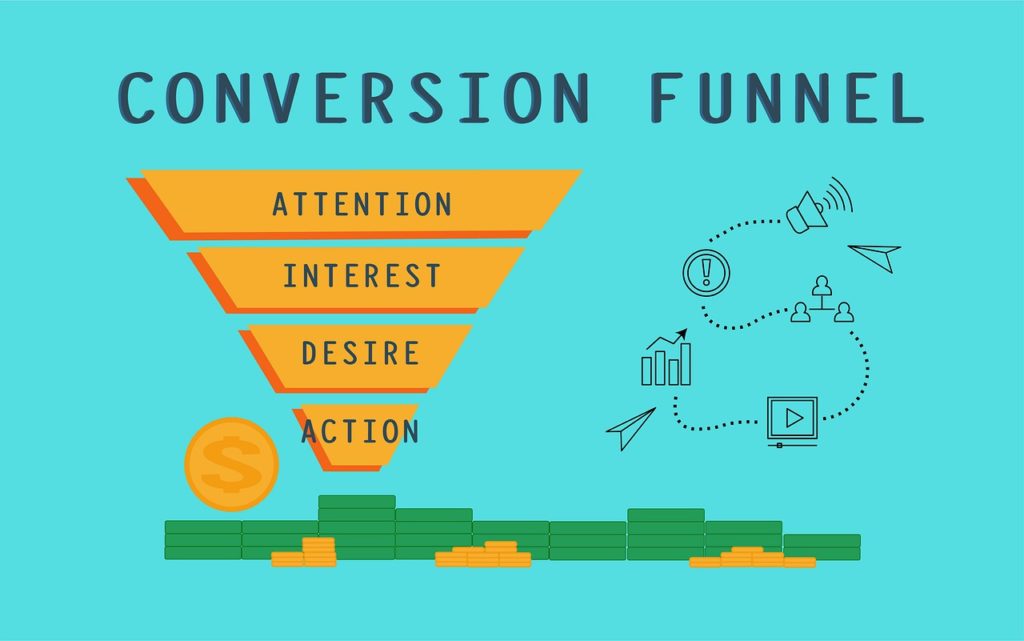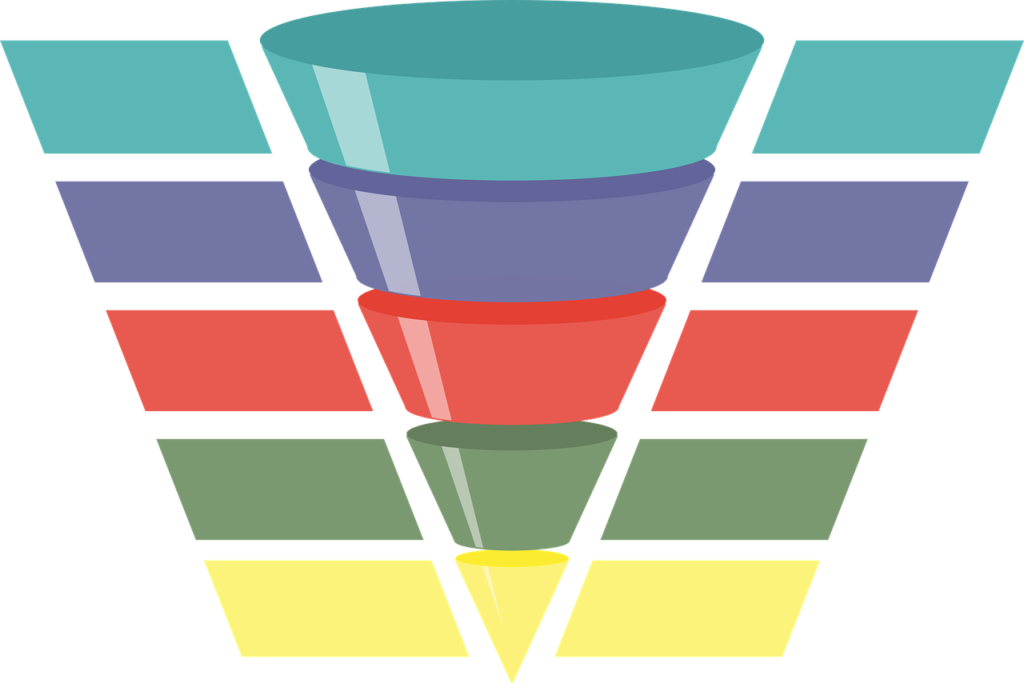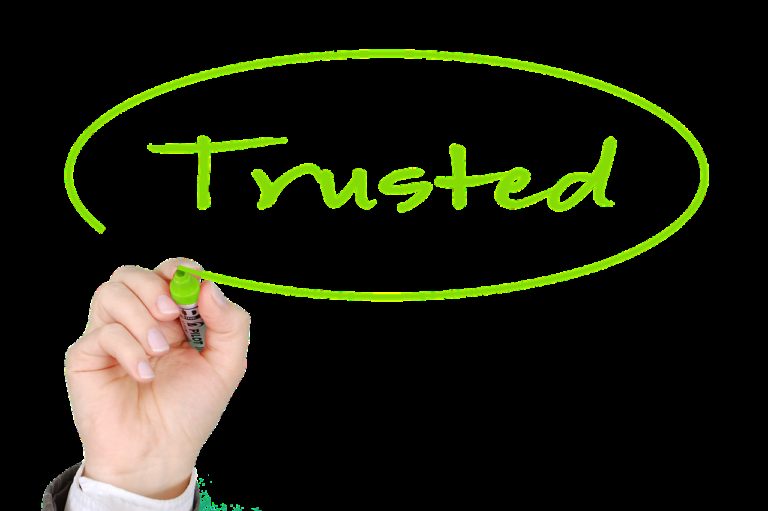A sales funnel is one of the most important concepts in digital marketing. While it may appear strange at first, this unique fundamental principle has the ability to transform a company from essentially non-existent and unknown to a multi-million-dollar marketing powerhouse with broad exposure. In fact, some excellent practitioners have made a career out of executing this specific business principle.
What is a Sales Funnel?
Imagine a real-world funnel, some substance is put into the funnel at the top, and it filters down to a single limited destination. Something similar happens in sales. Many people come at the top and may enter your funnel. However, unlike a real-life funnel, not everyone who enters the sales funnel will exit at the other end.
How visitors arrive at your website, from blogging to social media to paid advertisements and everything in between, has an influence on the performance of your funnel. Let’s look at the fundamental concepts of sales funnels to better grasp the notion of a sales funnel and how you can use it in your own business.
Stages of Sales Funnel

1. Awareness or Attention
What matters most about the sales funnel is what transpires when those visitors (also known as prospects) arrive. Those prospects enter your sales funnel through an intriguing offer through a variety of methods, many of which you’ve previously seen, such as email newsletter signups, ebook downloads, online quizzes, and more.
Your whole sales funnel and platform should be designed to solve your customer’s problem. The true magic comes when you understand the problem, create content to lure people in, and then give them a product or service to address their problem. However, getting to that point takes time and effort, and you must first gain their attention.
You’ve peaked the prospect’s consciousness once they’re in the funnel. The funnel’s initial stage is complete. However, getting a prospect to notice you is no easy task. Customers may interpret your funnel differently depending on how they got to your website (organically or through a sponsored ad), and your opt-in rates may vary dramatically.
When a buyer finds you organically, such as through a Google search, this indicates that you have some authority. Prospects are more likely to enter your funnel when you have authority because they know that if they discover you relevantly, whatever you’re offering must be of tremendous value. That’s precisely how SEO and organic search work.
Of course, regardless of how they join your funnel, as a marketer, your job is to progress them through the many phases that will lead them from prospect to buyer. You must then pique their attention once they are aware of you. You must first create a relationship with the consumer in order to do so. You may have attracted them with a terrific offer (lead magnet) in exchange for their email address, but pushing them through the funnel is a considerably more difficult task.
Is it true? People are intelligent. They won’t buy anything from anyone unless they believe there’s a lot of worth there. As a result, your funnel must build that value and bake it in through several methods. Most importantly, you must establish a deep relationship with your prospect, which you can do in your email warming sequence by being sympathetic, honest, and truthful.
2. Interest
An email series is used to stimulate the prospects’ attention. You start telling them stories about who you are and how you’ve gotten to this place in your life. Are you the reluctant hero whose journey happened almost by accident, yet you feel compelled to share something valuable with yourself and the world?

It is absolutely up to you how you position yourself, but your message must be consistent throughout your whole “pitch” and based on the facts. Your past, and how you portray it through parables, character flaws, and polarity, has a lot to do with how successfully you can “hook” in your potential supporters and start a mass movement.
Of course, putting this into practice is difficult. You must first build your stories, after which you must select how you will deliver them and at what tempo. For example, your first email or two may be sent the day they join up, and then one email every day after that. How much of it will be based on stories and how much on pitches?
You must also teach your prospects to click on links. You might, for example, have them click on a link to something that interests them, or link them to a blog post, or eventually to a product or service that you’re offering, but you’ll need to teach them to do so from the start.
3. Choosing
The choice is the next step. It’s not simple to persuade prospects to make a decision. What’s the most efficient way to get them there? You need a lot of customer evaluations and testimonials, in addition to the skill of storytelling, copywriting and developing the habit of link-clicking. This is one of the most effective methods for motivating individuals to act.
If you’re choosing the paid ad route, you can also utilize Facebook and Google retargeting to maintain that level of awareness and engagement. For example, if you’ve ever observed that you start seeing their advertisement everywhere after leaving a website, there’s a reason for it. This is a particularly effective technique to convince them to act if they’ve already entered your sales funnel.
You might, for example, send them retargeting advertisements with video testimonials or customer reviews. You might use this chance to highlight any media sources that have written about you. It’s just an extra level of exposure when they see this in your sales funnel and you follow them around with retargeting.
But, no matter how you persuade people to act, switching that switch isn’t easy. You must offer them a fantastic opportunity and employ one or more of Robert Cialdini’s six principles, defined in his 1984 book Influence, to advance them through this stage:
- Principle of reciprocity — This is done by providing a lot of value, either as a free gift (lead magnet) at the start or in a continuous exchange through your emails.
- Principle of commitment and consistency — People are significantly more inclined to buy from you if they commit to something. That’s why you should try to persuade them to agree to anything like a free shipping offer or to agree with what you’ve stated. This is a strong sales principle, and if you pay attention to some of the world’s finest marketers, you’ll notice that they work hard to obtain your commitment to anything, even if it’s tiny at first.
- The like principle states that when people like you (i.e. they relate to your tales), they are more inclined to buy from you. How well you design your narrative and present it to your prospects will have a significant impact on whether or not they act.
- The principle of authority — How powerful is your products or services? Are there any well-known members in your community who have endorsed it? Are there any scientific studies that back it up? Are you an authoritative figure yourself? In this process, all of these factors come into play.
- Social proof principle — Do you have social proof? Are people praising or talking about how fantastic your products or services are on social media? Do you have any other social proof? What about best-sellers? Something else, perhaps? If you have prospects, it’s critical that you offer this to them.
- Scarcity principle — How much scarcity have you included in your email sequence? People are clever, but when you use the idea of scarcity, such as when there are just a few days left before a deal expires or only a few seats available for an online class, it entices people to act.
4. Taking Action
The action that you want them to do is the final stage of the sales funnel. This is, in most situations, the buy. Again, how successfully you progress them through the various phases will determine which conversion you get for this action. For example, if 500 individuals click on your offer and 50 of them reach your sales funnel, but only five people buy your conversion rate is 1%.
The best aspect about this, and the most effective way for entrepreneurs to expand their businesses, is that if you know that getting 500 people to your site costs $ 500 and you get five individuals to convert at $300 each, you have a $1500 return on your $500 investment. When you realize this, the game changes completely, and you may indefinitely scale your offers.
This is how the world’s most successful marketers expand their firms. They recognize the importance of conversions and have fine-tuned and refined their sales funnels, so they go for broke by just scaling out their offerings. If you knew that investing $1 will return $3, you will continue to invest $1 indefinitely.
However, getting to this point is no easy task. It requires a lot of time and effort, as well as tracking. You can obviously reduce the hassle by using sales funnel tools, but there’s still a lot of work to be done. Copy must be written, tracking pixels must be set up, and email sequences must be developed. However, success necessitates this.
Conclusion
Consider the above tips the next time you’re creating a sales funnel. Through the skill of scaling out a highly-converting offer, this complicated and convoluted company idea may actually take you from the utter unknown to a worldwide superpower in no time. If you want to reap the benefits and outcomes, don’t try to cut corners or use hacks; instead, put in the effort.



